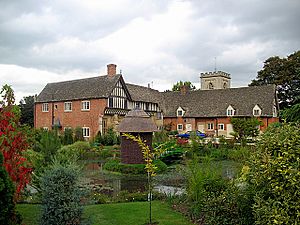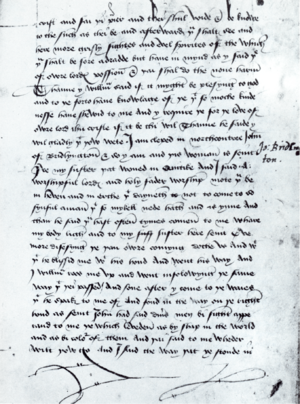John Theyer facts for kids
John Theyer (born 1597, died 1673) was an English lawyer, writer, and a big fan of old books and manuscripts. He was known for supporting the King during a difficult time in England's history. He also loved collecting old writings and had a very important library.
Contents
Life of John Theyer
John Theyer was born in 1597 in Brockworth, a small town in Gloucestershire, England. His father was also named John Theyer. When he was about 16, John went to Magdalen College, Oxford, to study. After three years there, he decided to study law at New Inn.
John Theyer lived mostly at Cooper's Hill, Brockworth, an estate his father gave him when he got married in 1628. He became good friends with Anthony Wood, who was another famous historian. Wood often visited Theyer to use his amazing library.
When the First English War (also known as the English Civil War) began in 1642, John Theyer was a strong supporter of King Charles I. He tried to protect a church in Painswick from damage by Parliament's soldiers. His wife's family had an important tomb there. Theyer was fined for his actions. In 1643, he joined the King's army in Oxford. Around this time, he became a Roman Catholic.
Because he supported the King, the Parliament took away his property. They saw him as one of the King's most loyal followers. His family faced many hardships until his property was returned on November 4, 1652.
John Theyer passed away at Cooper's Hill on August 25, 1673. He was buried in the churchyard at Brockworth.
John Theyer's Writings
John Theyer wrote a book called Aerio Mastix, or a Vindication of the Apostolicall and generally received Government of the Church of Christ by Bishops. He gave a copy of this book to King Charles I in 1643. This book was about how the church should be run, arguing that bishops should lead it. It was a big topic of discussion at the time.
Because of his good work, King Charles I gave him a special Master of Arts (M.A.) degree on July 6, 1643. Theyer also started writing another book called A Friendly Debate between Protestants and Papists, but he did not finish it before he died.
Theyer's Family
John Theyer and his wife, Susan, had a son named John. This son later had a son named Charles (born in 1651). Charles went to University College, Oxford, in 1668. He might have been the same Charles Theyer who became a lecturer in Totteridge and published a sermon in 1707.
John Theyer's Amazing Library
John Theyer inherited many old manuscripts from Richard Hart. Hart was a prior (a leader in a monastery) and also Theyer's great-uncle. Hart had built Brockworth Court and had a large collection of handwritten books. This inheritance made John Theyer very interested in collecting old writings himself.
Theyer collected many manuscripts, especially from the West Midlands area of England. He bought old books from religious houses like Buckfast Abbey and Hailes Abbey.
When John Theyer died, he left 800 manuscripts to his grandson, Charles. Charles Theyer tried to sell them to Oxford University. The Bodleian Library sent someone to look at them, but they didn't buy them. So, the manuscripts were sold to Robert Scott, a bookseller in London.
Later, King Charles II bought 336 of these valuable volumes for the Royal Library. This collection was a very important addition to the King's library during that time. Today, the entire collection is part of the British Museum's collection, known as the Royal manuscripts, British Library.
Special Items in Theyer's Library
John Theyer's library contained many fascinating and rare items. These included:
- Works by Roger Bacon, a famous medieval scientist.
- Manuscripts that belonged to Thomas Cranmer, an important leader of the English Reformation.
- Copies of famous literature like The Canterbury Tales by Geoffrey Chaucer.
- A manuscript of Dives and Pauper, a religious work from around 1400.
- An old Anglo-Saxon prayer book from about 820 AD. This book was written in Latin with notes in an old English dialect called Mercian. It might have been made for a female doctor!
- Perhaps the most famous item was the Westminster Psalter (Royal 2. A. xxii). This was a psalter (a book of psalms) from Westminster Abbey. It had beautiful pictures, called illuminations, that were started around 1200. The British Library says it has "some of the most elegant and refined painting of the period."



